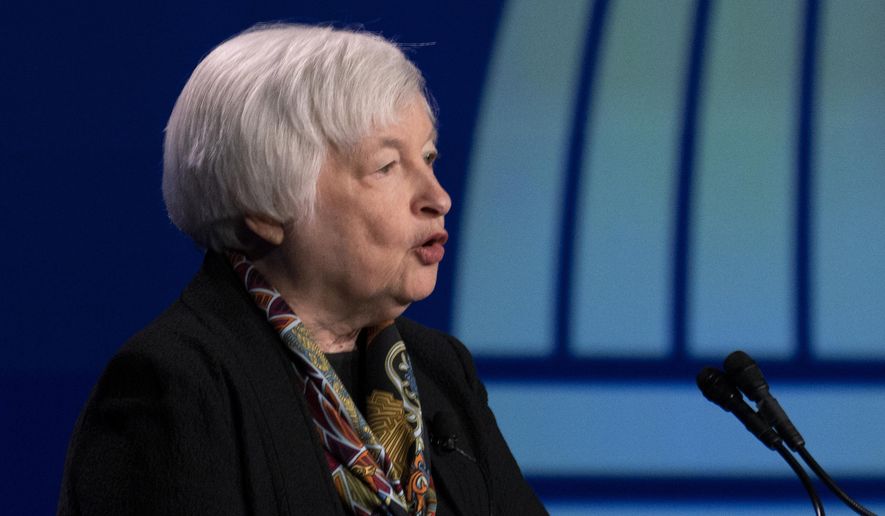Treasury Secretary Janet Yellen told a roomful of bankers Tuesday that the U.S. banking system is “stabilizing,” but she’s still not sure why two banks failed and a third needed to be rescued by other large banks in the past two weeks.
Addressing the American Bankers Association summit in Washington, Ms. Yellen said Tuesday that the administration’s actions to close Silicon Valley Bank in California and Signature Bank in New York “reduced the risk of further bank failures.” They were the second- and third-largest bank failures in U.S. history.
Ms. Yellen said the bank collapses were “very different” from the financial meltdown of 2008, which resulted in trillions in losses.
“2008 was a solvency crisis, rather what we’re seeing now is contagious bank runs,” she said.
But she said she doesn’t know yet what caused the bank failures this month, which led to fears of a broader run on bank deposits.
“In the coming weeks, it will be vital for us to get a full accounting of exactly what happened in these bank failures,” Ms. Yellen said. “We don’t yet have all the details about these two banks. There’s time to evaluate whether some adjustments are necessary in supervision and regulation to address the root causes of the crisis. I’m focused on stabilizing our system.”
Many economists are blaming the impact of high inflation, which has prompted the Federal Reserve to raise interest rates eight times in the past year. The higher rates, in turn, have caused a cash crunch at some banks by lowering the value of their long-term investments.
Ms. Yellen told a Senate committee last week that she doesn’t believe high spending in Washington is a primary cause of high inflation.
Sen. Steve Daines, a Montana Republican on the Senate Banking Committee, said congressional hearings need to focus on why federal and state regulators didn’t catch the banks’ problems before it was too late. He said he strongly disagrees that the solution is stricter banking regulation.
“First and foremost, I want to see a timeline of what happened,” Mr. Daines told the bankers. “I want to hear from the regulators about who was responsible for catching this and literally who did not.”
Ms. Yellen and the heads of the Federal Reserve and the Federal Deposit Insurance Corp. worked out an emergency response that guaranteed depositors their money back beyond the normal $250,000 limit. The bailout will be paid for by fees on other banks.
Mr. Daines criticized that approach.
“I worry that the actions by the administration to date are going to leave solvent banks on the hook for the failure of regulators, for the failures of management … of these banks,” he said.
Scott Anderson, president of Zions Bank, said he doesn’t think a rollback of some bank regulations by Congress in 2018 contributed to the bank failures.
“Congress needs to be careful,” Mr. Anderson said during a panel discussion. “They need to look at what happened. They need to have a thorough debate and a thorough discussion. But they shouldn’t jump to any immediate conclusions. I don’t think these failures show that there’s any problem within the banking regulations that we have now.”
The Treasury Department and the Federal Reserve also brokered a deal with 11 of the nation’s largest banks to deposit a total of $30 billion in the troubled First Republic Bank over the weekend.
Ms. Yellen said the support “represents a vote of confidence in our banking system.”
“Our intervention was necessary to protect the broader U.S. banking system,” she said in her prepared remarks. “The U.S. banking system remains sound. Aggregate deposit outflows from regional banks have stabilized.”
She said the Treasury Department “is committed to ensuring the ongoing health and competitiveness of our vibrant community and regional banking institutions.”
Another big development for banks will come Wednesday when the Fed announces its decision on another increase in its benchmark interest rate.
The central bank’s series of eight rate increases in the past year is being blamed partly for causing a cash crunch in some banks that invested in long-term bonds and securities when interest rates were low.
The Fed has been raising rates to fight 40-year high inflation, which peaked at 9.1% last summer. Inflation fell to an annual rate of 6% in February, but that is still triple the Fed’s target level of 2%.
• Dave Boyer can be reached at dboyer@washingtontimes.com.




Please read our comment policy before commenting.